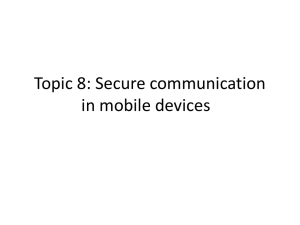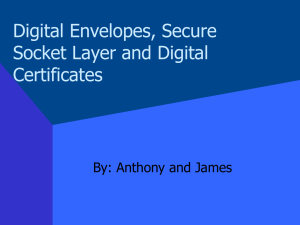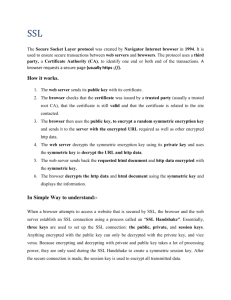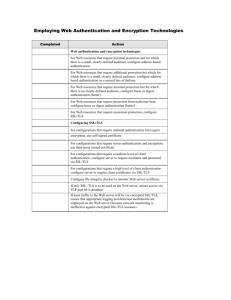A Tutorial on Web Security for E-Commerce
advertisement
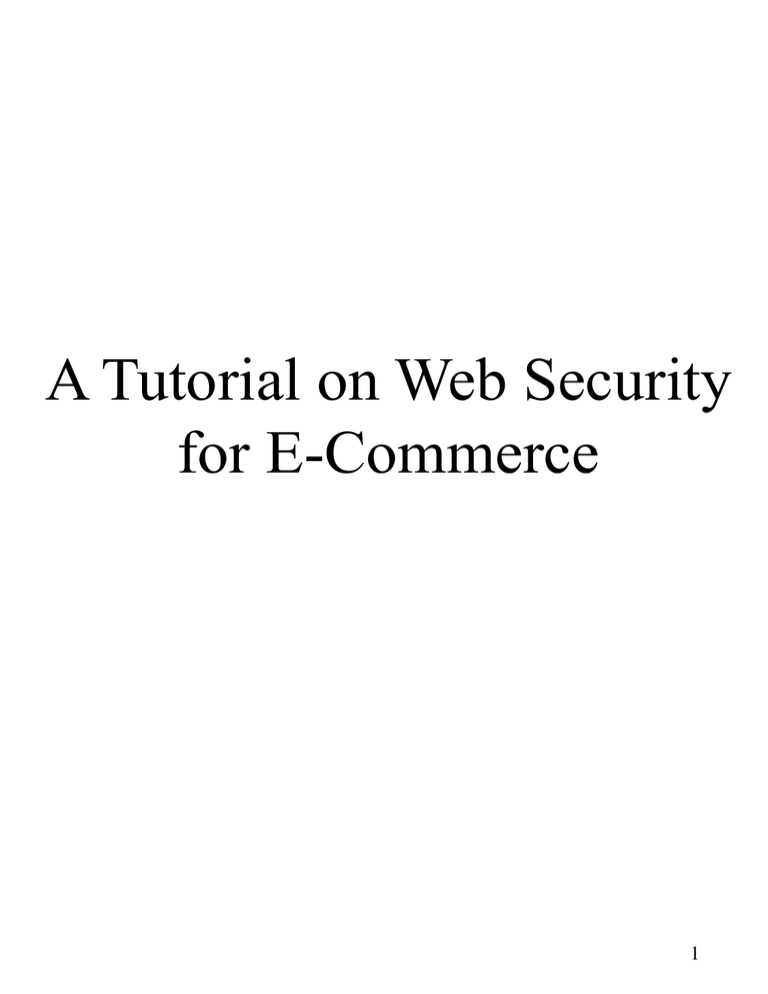
A Tutorial on Web Security for E-Commerce 1 Web Concepts for E-Commerce • Client/Server Applications • Communication Channels • TCP/IP 2 Client/Server Applications Request Client Server Response 3 Communication Channels Internet Client Intranet Server Extranet 4 OSI Model Application Allows access to network resources Presentation Translates, encrypts and compresses data Session Establishes, manages and terminates sessions Transport Provides end-to-end message delivery & error recovery Network Moves packets from source to destination; Provides internetworking Data Link Organizes bits into frames; Provides node-to-node delivery Physical Transmits bits; Provides mechanical and electrical specifications 5 OSI Model Client cont’d Intermediate Intermediate Node Node Server Application Peer-to-peer protocol (7th layer) Application Presentation Peer-to-peer protocol (6th layer) Presentation Session Peer-to-peer protocol (5th layer) Session Peer-to-peer protocol (4th layer) Transport 3rd 3rd Network Network 2nd Data Link 2nd 1st Physical 3rd Network Data Link Network 2nd Data Link Data Link 1st Physical Transport 1st Physical Physical 6 TCP/IP and OSI Model Application Presentation Applications SMTP TELNET SNMP NFS RPC FTP DNS TFTP HTTP Session Transport UDP TCP Network ICMP Data Link Physical IP ARP RARP Protocols defined by the underlying networks 7 TCP/IP and OSI Model cont’d Application Message Presentation Applications Session Segment Transport TCP UDP Network Datagram IP Frame Data Link Physical Protocols defined by the underlying networks Bits 8 TCP/IP and Addressing Application layer Processes Transport layer TCP UDP Port address Network layer Data link layer Physical layer IP and other protocols IP address Underlying physical networks Physical address 9 Typical B2C Transaction Bank Bank Katie’s Bank CD Store Merchant’s Bank Internet Payment Network Katie’s order Online CD Store Web Server ISP CD Order printed at CD warehouse Warehouse Katie sends Order Form CD arrives 2-3 days after order is received 10 Web Security Threats in B2C Internet Backbone E Breaking into store database D Online CD Store Web Server ISP C Sniffer on Internet backbone B Sniffer at ISP CD Warehouse A Tapping line Katie 11 Security Threats • Security threats A to D can be handled by providing secure transmission - cryptographic methods • Threat E and similar types managed by access control methods • Other types of security threats – Illegal access of server computing system (webjacking) – Illegal access client computing system – Unauthorized use of client information – Denial of Service 12 Information Security Threats • Internet Cryptography Techniques • Transport Layer Security • Application Layer Security • Server Proxies and Firewalls 13 Purpose of Cryptography • Secure stored information regardless if access obtained • Secure transmitted information regardless if transmission has been monitored 14 Services Provided by Cryptography • Confidentiality – provides privacy for messages and stored data by hiding • Message Integrity – provides assurance to all parties that a message remains unchanged • Non-repudiation – Can prove a document came from X even if X’ denies it • Authentication – identifies the origin of a message – verifies the identity of person using a computer system 15 Cryptography • Encryption Overview – Plain text is converted to cipher text by use of an algorithm and key. • Algorithm is publicly known • Key is held private – Three Main Categories • Secret Key – single key is used to encrypt and decrypt information • Public/Private Key – two keys are used: one for encryption (public key) and one for decryption (private key) • One-way Function – information is encrypted to produce a “digest” of the original information that can be used later to prove its authenticity 16 Encryption Techniques • Secret Key (Symmetric) – Sender and receive have the same secret key that will encrypt and decrypt plain text – Strength of encryption technique depends on key length – Known symmetrical algorithms • Data Encryption Standard (DES) – 56 bit key • Triple DES, DESX, GDES, RDES – 168 bit key • RC2, RC4, RC5 – variable length up to 2048 bits • IDEA - basis of PGP – 128 bit key • Blowfish – variable length up to 448 bits 17 Encryption Techniques (con’t) • Asymmetric Encryption (Public/Private Key) – user X has a pair of keys one public and one private – To encrypt a message to X use X’s public key – X will decrypt encrypted message using X’s private key that “matches” X’s public key – Most common algorithm is the RSA (Rivest Shamir Adelman) algorithm with key lengths from 512 to 1024 bits. 18 Encryption Techniques (con’t) • One-Way Function – non-reversible “quick” encryption – produces a fixed length value called a hash or message digest – used to authenticate contents of a message – Common message digest functions • MD4 and MD5 – produces 128 bit hashes • SHA – produces 160 bit hashes 19 Cryptographic Services Allow • Digital Signatures – sign messages to validate source and integrity of the contents • Digital Envelopes – secure delivery of secret keys • Message Digests – short bit string hash of message • Certificates (Digital Ids) – used to authenticate: users, web sites, public keys of public/private pair, and information in general • Secure Channels – Encryption can be used to create secure channels over private or public networks 20 Digital Signatures • Digital Signature – Encrypt sender’s identity string with sender’s private key – Concatenate the encrypted text and the identity string together – Encrypt this message with receiver’s public key to create message – Receiver decrypts the encrypted text with their private key – the cypher text portion of the message is decrypted with sender’s public key – The decrypted text can be compared with the normal text to checks its integrity 21 Digital Envelope • Public/Private key encryption / decryption useful for internet • Limitations – encryption / decryption slow – not reasonable for large documents • Combine symmetric and asymmetric methods – sender creates and uses symmetric (session) key to create cipher text – sender uses receiver’s public key to encrypt the symmetric key digital envelope – sender transmits both cipher text and digital envelope to receiver 22 Message Digests • How to create and use a message digest – sender uses message as input to digest function – “sign” (encrypt) output (hash) with sender’s private key – send signed hash and original message (in plain text) to receiver – receiver decrypts hash with sender’s public key – receiver runs plain text message through digest function to obtain a hash – if receiver’s decrypted hash and computed hash match then message valid. 23 Digital Certificates (ID) • Certification Authorities (CA) – used to distribute the public key of a public/private pair – guarantees the validity of the public key • does this by verifying the credentials of the entity associated with the public key – Some Case • Versign - http://www.versign.com • U.S. Post Office - http://www.ups.gov • CommerceNet - http//www.commerce.net – certificates contain • public key • e-mail • full name • Digital certificates are secure – cannot be forged nor modified 24 Digital Certificates • Process to create Digital Certificate – User generates public/private pair – User creates and sends a certificate request • contains: identifying information and user’s public key – CA verifies this information – CA creates a certificate containing user’s public key and information – CA creates message digest from certificate and signs it with CA’s private key – This a signed certificate 25 Digital Certificates • Using a Digital Certificate – before sending a secure message sender request a signed certificate from receiver – sender decrypts signed certificate with CA’s known public key to obtain message digest of info and public key provided to CA by receiver – sender creates a message digest of public key and info provided by the receiver for sender’s use – sender compare the message digests if they match then receiver is validated. 26 Digital Certificates • Types of Digital Certificates – site certificates • used to authenticate web servers – personal certificates • used to authenticate individual users – software publishers certificates • used to authenticate executables – CA certificates • used to authenticate CA’s public keys – All certificates have the common format standard of X.509v3 27 Secure Channels • Encrypted Traffic may use – Symmetric Key – Public/Private Key • Negotiated Secure Session – Secure Socket Layer (SSL) – Transport Layer Security (TLS) – SSL or TLS provides these services • Authenticate users and servers • Encryption to hide transmitted data symmetric or asymmetric • Integrity to provide assurance that data has not been altered during transmission – SSL or TLS require certificates to be issued by a CA 28 Secure Channels (con’t) • Internet Tunnels – virtual network circuit across the Internet between specified remote sites – uses an encrypting router that automatically encrypts all traffic that traverses the links of the virtual circuit • Tunneling Protocols – PPTP by Microsoft http://www.microsoft.com – Layer 2 Forwarding (L2F) by Cisco - http://www.cisco.com – L2TP (combines PPTP and L2F) http://www.ietf.com 29 Secure Sockets Layer • SSL History – Competitor to S-HTTP – S-HTTP an extension of HTTP – General purpose encryption system using symmetric encryption – S-HTTP only encrypts Web protocols – Three versions v1.0, v2.0 and v3.0 • SSL v3.0 implemented in Netscape 3.0 and Internet Explorer 3.0 and higher • SSL v3.0 supports Diffie-Hellman anonymous key exchange and Fortezza smart card 30 Secure Sockets Layer • SSL Characteristics – Operates at the TCP/IP transport layer – Encrypts (decrypts) input from application (transport) layer – Any program using TCP can be modified to use SSL connections – SSL connection uses a dedicated TCP/IP socket (e.g. port 443 for https or port 465 for ssmtp) 31 Secure Sockets Layer • SSL Characteristics – SSL is flexible in choice of which symmetric encryption, message digest, and authentication algorithms can be used – When SSL client makes contact with SSL server they try to pick strongest encryption methods they have in common. – SSL provides built in data compression • compress first then encrypt 32 Secure Sockets Layer • SSL Characteristics – When SSL connection established browser-to-server and server-tobrowser communications are encrypted. This includes: • • • • • • • URL of requested document Contents of the document Contents of browser forms Cookies sent from browser to server Cookies sent from server to browser Contents of HTTP header But NOT particular browser to particular server – socket addresses not encrypted – can use proxy server for privacy 33 Secure Sockets Layer • Establishing an SSL Connection – The client (browser) opens a connection to server port – Browser sends “client hello” message. Client hello message contains: • version of SSL browser uses • ciphers and data compression methods it supports – The Server responds with a “server hello” message. Server hello message contains • session id • the chosen versions for ciphers and data compression methods. 34 Secure Sockets Layer • Establishing an SSL Connection (con’t.) – The server sends its certificate • used to authenticate server to client – Optionally the server may request client’s certificate – If requested, client will send its certificate of authentication • if client has no certificate then connection failure – Client sends a “ClientKeyExchange” message • symmetric session key chosen • digital envelope is created using server’s public key and contains the symmetric session key 35 Secure Sockets Layer • Establishing an SSL Connection (con’t.) – Optionally, if client authentication is used the client will send a certificate verify message. – Server and client send “ChangeCipherSpec” message indicating they are ready to begin encrypted transmission. – Client and server send “Finished” messages to each other • These are a message digest of their entire conversation up to this point. • If the digests match then messages were received without interference. 36 SSL Connection Setup Client (Browser) 1. Client sends ClientHello message Server 2.Server acknowledges with ServerHello message . Session Key 3. Server sends its certificate (4. Server requests client’s certificate) Server Certificate (5. Client sends its certificate) Server’s public key Client Certificate Server’s private key 6. Client sends “ClientKeyExchange” message Digital envelope X (7. Client sends a “Certificate Verify” message) Digital signature Session key 8. Both send “ChangeCiperSpec” messages 9. Both send “Finished” messages 37 Transport Layer Security TLS • IETF (Internet Engineering Task Force) Standard for secure connection • Derivative of SSLv3.0 • Uses different digest functions and different set of encryption algorithms • see TLS URL for more details – http://www.consensus.com/ietf-tls/ • see SSL URL for more details – WBSRV = home.netscape.com/ • WBSRV/newsref/std/SSL.html • WBSER/ref/internet-security.html 38 Application Layer Security • Secure Electronic Transactions – SET • Digital Payment Systems – – – – First Virtual CyberCash DigiCash Millicent • Pretty Good Privacy – PGP: used to secure e-mail • These are the applications sender/receiver use to give secure communication 39 Secure Electronic Transactions • Cryptographic protocol • Developed by Visa, Mastercard, Netscape, and Microsoft • Used for credit card transactions on the Web • Provides – Authentication of all parties in transaction – Confidentiality: transaction is encrypted to foil eavesdroppers – Message integrity: not possible to alter account number or transaction amount – Linkage: attachments can only be read by 3rd party if necessary 40 Secure Electronic Transactions • SET protocol supports all features of credit card system – – – – – – – – – Cardholder registration Merchant registration Purchase requests Payment authorizations Funds transfer (payment capture) Chargebacks (refuns) Credits Credit reversals Debit card transactions • SET can manage – real-time & batch transactions – installment payments 41 Secure Electronic Transaction 1. Customer browses and decides to purchase 2. SET sends order and payment information Customer Merchant 7. Merchant completes order 9. Issuer sends credit card bill to customer 3. Merchant forwards payment information to bank 8. Merchant captures transaction 6. Bank authorizes payment 4. Bank checks with issuer for payment authorization Bank Bank 5. Issuer authorizes payment Customer’s bank “Issuer” Merchant’s bank 42 Securing Private Networks • Minimize external access to LAN • Done by means of firewalls and proxy servers • Firewalls provide a secure interface between an “inner” trusted network and “outer” untrusted network • every packet to and from inner and outer network is “processed” • Firewalls require hardware and software to implement • Three main hardware architectures – dual-homed host – screened gateway – screened subnet gateway 43 Dual Homed Gateway Gateway (Bastion) Proxies Local Area Network Internet Private Net Outside Blocked 44 Screened Host Gateway Gateway (Bastion) Allowed Proxies Allowed Local Area Network Router Internet Private Net Outside Blocked 45 Screened Subnet Gateway Web Server Gateway (Bastion) LAN Router Router Internet Private Net Demilitarized Zone 46 Securing Private Networks • Software that is used are proxies and filters that allow or deny network traffic access to either network • Proxy programs – application-level – circuit-level • Filters – packet filtering 47 Securing Private Networks • Application level proxies – written for each particular protocol • e.g. HTTP or FTP or SMTP – regardless of protocol its function is to forward or not forward messages across firewall – they decide based on TCP/IP information • e.g. source and destination ports and IP addresses – they decide based on content of message • e.g. do not forward on and message containing VB executable or ActiveX components 48 Securing Private Networks • Circuit level proxies – software’s function is to forward or not forward packets across firewall – decides only on basis of header information in the packet • i.e. source and destination IP addresses and port numbers – they cannot peek into packet – advantage • very fast - less computation required • very general - handle many protocols – SOCKS • freeware circuit level proxy – SMLI • stateful multilayer inspection gateway • correlates incoming and outgoing packets 49 Securing Private Networks • Packet Filtering – technically not software – used with screen host or screened subnet host architecture – uses router’s routing table to decide which packets to forward or not forward – if bastion does not have proxy for a given service (e.g. TFTP) then packet filter can be configured to bypass firewall 50 Access Security Threats • Access Control – Threats • Webjacking: site vandalism – Countermeasures • User Authentication • User Authorization • Denial of Service – Threat • Unable to user server resources • Type of DOS Attacks – Counter Measures (limited) • Firewalls • System Configuration 51 Access Control • User authentication – process used to identify user who accesses a web server – determines legitimate user – Generally referred to as access control • User authorization – once user authenticated specifies what server resources that user may access – resources are: files, scripts, and directories 52 User Authentication • Several type of access control – Based on IP address • validates web browser based on its host’s IP address – Based on Domain Name • validates web browser based on its host’s domain name – Based on user name and password • User of browser is validated on basis of user ID and its associated password – Based on client certificates • remote user is issued a secure certificate to use as a digital signature – Based on network security protocols • solves validation problems associated with accessing via LAN and WAN • e.g. Kerberos and DCE 53 Authentication based on host IP address and/or DNS name • Screen browsers based on their source IP address, Domain Name, network,or subnetworks • Advantages – easy to set up – not likely to be incorrectly configured • Disadvantages – difficult to grant access to users who migrate – difficult hand DHCP protocol and Web proxies – security issues of • DNS spoofing • IP spoofing 54 Countermeasures to DNS Spoofing • DNS Spoofing – Attacker assumes control if DNS host/name lookup system • Counter by – Paranoid DNS checking • Upon receiving packet from browser server uses that source IP address to make two DNS requests • First resolves IP address to get a Domain Name • Returned domain name used to find its IP address • if domain name correlates with IP address then legitimate remote host – Use a firewall’s DNS lookup 55 Countermeasures to IP Spoofing • IP spoofing requires technical expertise • Uses source routing protocol – appears as if request originates from within LAN – can be used to insert CGI script or modify OS • Prevented by – configuring routers and firewalls to reject connections using source routing protocol – configure the server’s operating system to reject connections using source routing 56 Authentication Based on User ID and Password • Requires user to provide protected information in order to be authenticated • Advantages – Authenticates users not hosts – Users can migrate from host to host – No problems with Web proxies or DHCP • Disadvantages – Users share passwords, forget passwords, do not keep passwords private, or choose poor passwords – passwords can be “sniffed” if transmitted over a network 57 Authentication Based on User ID and Password • Countermeasures to disadvantages – Users share passwords, forget passwords, do not keep passwords private, or they choose poor passwords • User education • Chose hard passwords but easy to remember 58 Authentication Based on User ID and Password • Countermeasures to disadvantages – passwords can be “sniffed” if transmitted over a network • Basic authentication is carryout in plain text but coded in Base 64 MIME HTTP/1.0 • Can be intercepted and decoded • Since HTTP protocol stateless every access to protected resource needs to be authenticated • Basic Authentication process occurs frequently hence more opportunity to be sniffed. – Use secure transmissions • HTTP/1.1 uses Digest Authentication process • Use encrypted communications e.g. SSL connection 59 Client Based Certificate System • Certificates – when user logs on (presents their certificate) the authentication server verifies the certificate is valid by opening it with the CA’s public key – certificate contains users public key and personal information. – Server sends a challenge to the user a one-time value the user signs with their private key – Server then signs the same value with its copy of the user’s private key – If the signatures match then user is authenticated 60 Other Forms of Access Control • Kerberos authentication model – Uses a secure “key server” – Once user authenticated free to use any resources of the system – All transmissions are encrypted • Distributed Computing Environment – DCE is designed by Open Software Foundation – Similar to Kerberos authentication model • Two Factor Authentication • need something you have - ATM card • need something you know - PIN number 61 Other Forms of Access Control • Smart Card Type – token access device that has information that is in sync with server information (e.g. counter, time, random number generator, etc.) – “One time pad” of user name and password 62 Denial of Service • Some Types of Attack – TCP/IP SYN attack • To set TCP/IP connection use a three step “handshake” protocol – client requests – server acknowledges and waits – client acknowledges • if no client acknowledgement or many client requests then server overwhelmed. – PING of Death • many clients “ping” server – Flood server with URL requests • either one client or many in parallel • DDOS attack 63 Denial of Service • Countermeasures to DOS – Minimal counter measures after attack has started • DOS attacks require client(s) to carry requests • locate source(s) of requests and terminate those processes – Countermeasures prior to attack • prevent attacks by making sure all hosts a going to be used legitimately • requires securing all remote hosts not likely • e.g. DDOS: number of freeware programs that when run will create SYN flooding attack make sure remote host does not run this program. 64

